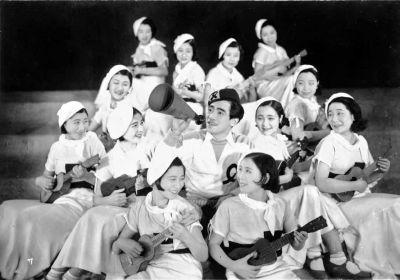
ENOKEN SEISHUN SUIKODEN
(Romantic and Crazy / Romantico e folle, Giappone/1934) R.: Kajiro Yamamoto. D.: 85'
[Romantico e folle] T. int.: Romantic and Crazy. Sog., Scen.: P.C.L. Bungeibu, Pierre Brillant Theatre. F.: Hiromitsu Karasawa. Scgf.: Takeo Kita. Mus.: Kyosuke Kami. Su.: Koji Hayakawa. Int.: Kenichi Enomoto (se stesso), Teiichi Futamura, Masako Tsutsumi, Sachiko Chiba, Heihachiro Okawa. Prod.: P.C.L. 35mm. D.: 85'. Bn. Versione giapponese con sottotitoli inglesi / Japanese version with English subtitles
Da: National Film Center - The National Museum of Modern Art, Tokyo
La copia si basa su un controtipo negativo 35mm acquistato grazie a un fondo nazionale supplementare stanziato nel 2009 dalla Agenzia per gli Affari Culturali e in seguito restaurato dal National Film Center. Colonna sonora sottoposta a riduzione del rumore / The current print is based on a 35mm dupe negative bought using a supplementary national budget provided for the purchase of film by the Agency for Cultural Affairs in 2009, and later restored by the NFC. The soundtrack has undergone noise reduction
I primi film musicali della P.C.L., osservano Joseph Anderson e Donald Richie, "non erano tanto veri film ma piuttosto numeri di varietà filmati, molti dei quali effettivamente finanziati da compagnie discografiche ansiose di pubblicizzare i loro artisti e le loro canzoni". Anderson e Richie fanno bene a segnalare gli stretti legami tra i diversi media commerciali agli inizi del sonoro, ma il trattamento condiscendente che riservano a quei film è ingiustificato. Il primo film sonoro interpretato da Enoken, il cui titolo è un gioco di parole su un classico della letteratura cinese, Shuihu Zhuan o in giapponese Suikoden (letteralmente "Storia in riva all'acqua"), bilancia l'estetica del sonoro con quella del teatro di rivista. Kenichi Enomoto (Enoken) era già apparso in vari film muti, ma era più noto come artista di varietà di Asakusa, il quartiere dei teatri di Tokyo. La casa di produzione ingaggiò anche la sua troupe e la trama fu costruita intorno alle scene che lo avevano reso famoso sul palcoscenico. I numeri in cui l'attore 'rompe la quarta parete' per chiedere consigli al pubblico rimandano alle origini teatrali del film. I manifesti pubblicitari dell'epoca vantarono "il comico numero uno e la commedia musicale numero uno del Giappone", spingendosi a millantare l'approvazione di Eddie Cantor e dei fratelli Marx. In effetti il film si ispirava consapevolmente al musical di Hollywood, sin dall'esplicito omaggio iniziale a Il re dell'arena (1932), interpretato proprio da Cantor. Il film segna il debutto alla P.C.L. del regista Kajiro Yamamoto, che in precedenza aveva lavorato alla Nikkatsu. Il regista rimase fedele alla compagnia anche quando essa si fuse con la J.O. per dar vita alla Toho, e la sua collaborazione con Enoken si estese fino al dopoguerra. Lavorò anche ad alcuni adattamenti letterari, come i due film tratti dalle opere del romanziere del periodo Meiji Soseki Natsume, Il signorino (1935) e Io sono un gatto (1936). Mentore di Akira Kurosawa, che fu suo aiuto regista in Uma (Cavallo, 1941) e in altri film, Yamamoto influenzò profondamente la storia del cinema giapponese.
Alexander Jacoby, Johan Nordström
P.C.L.'s early musicals, Joseph Anderson and Donald Richie complained, were "not actual movies so much as photographed vaudeville turns, many actually sponsored by record companies anxious to publicize their songs and artists". But while Anderson and Richie are right to point to the close ties between different commercial media during the early sound period, their slighting dismissal of the films is unwarranted. Enoken's first sound film, whose title puns on the title of a classic of Chinese litterature, The Water Margin (Shuihu Zhuan or Suikoden in Japanese), is self-consciously a multimedia work, which balances the aesthetics of the sound film with those of the stage revue. The revue artist Kenichi Enomoto (Enoken) had already appeared in a number of silent films, but was best known as a stage per- former, having made his name as a comedian in Tokyo's theatrical district of Asakusa. The film employed not only the star, but his entire theatrical troupe, and the narrative was structured around scenes which Enoken had played successfully on stage. Gags where the star 'breaks the fourth wall' to ask the advice of the audience glance back to the film's origins in live theatre. Billed as offering "Japan's number one comedy actor and Japan's number one musical comedy", the film selfconsciously borrows from Hollywood musical comedy, with the opening scene paying homage to the Eddie Cantor vehicle The Kid from Spain (1932). Indeed, on its original release, the posters carried spoof endorsements by Eddie Cantor and the Marx Brothers! Director Kajiro Yamamoto, who had been working previously at Nikkatsu, made his P.C.L. debut with this film. He was to become a stalwart of the company and its successor, Toho, with his collaboration with Enoken extending into the postwar era. In addition, he worked on literary adaptations such as two films based on the work of Meijiera novelist Soseki Natsume, Botchan (1935) and I Am a Cat (1936), and was to have a profound influence on the history of the Japanese cinema as mentor to Akira Kurosawa, who served as his assistant on a number of films including Uma (Horse, 1941).
Alexander Jacoby, Johan Nordström

Il Cinema Ritrovato 2013
 Il Giappone parla! Seconda parte. Cantanti e spadaccini
Il Giappone parla! Seconda parte. Cantanti e spadaccini
Tariffe:

Numero posti: 144
Aria condizionata
Accesso e servizi per disabili
Il nostro cinema aderisce al circuito CinemAmico: è possibile utilizzare l’applicazione MovieReading® per i film di cui è prevista audiodescrizione e/o sottotitolazione sull'applicazione.
Tel. 0512195311










